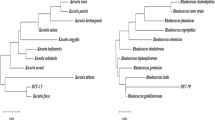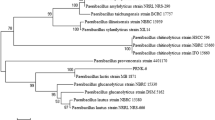Abstract
Sinorhizobium sp. C4 was isolated from a polycyclic aromatic hydrocarbon (PAH)-contaminated site in Hilo, HI, USA. This isolate can utilize phenanthrene as a sole carbon source. Sixteen metabolites of phenanthrene were isolated and identified, and the metabolic map was proposed. Degradation of phenanthrene was initiated by dioxygenation on 1,2- and 3,4-C, where the 3,4-dioxygenation was dominant. Subsequent accumulation of 5,6- and 7,8-benzocoumarins confirmed dioxygenation on multiple positions and extradiol cleavage of corresponding diols. The products were further transformed to 1-hydroxy-2-naphthoic acid and 2-hydroxy-1-naphthoic acid then to naphthalene-1,2-diol. In addition to the typical degradation pathways, intradiol cleavage of phenanthrene-3,4-diol was proposed based on the observation of naphthalene-1,2-dicarboxylic acid. Degradation of naphthalene-1,2-diol proceeded through intradiol cleavage to produce trans-2-carboxycinnamic acid. Phthalic acid, 4,5-dihydroxyphthalic acid, and protocatechuic acid were identified as probable metabolites of trans-2-carboxycinnamic acid, but no trace salicylic acid or its metabolites were found. This is the first detailed study of PAH metabolism by a Sinorhizobium species. The results give a new insight into microbial degradation of PAHs.





Similar content being viewed by others
References
Adachi K, Iwabuchi T, Sano H, Harayama S (1999) Structure of the ring cleavage product of 1-hydroxy-2-naphthoate, an intermediate of the phenanthrene-degradative pathway of Nocardioides sp. strain KP7. J Bacteriol 181:757–763
Ahmad D, Mehmannavaz R, Damaj M (1997) Isolation and characterization of symbiotic N2-fixing Rhizobium meliloti from soils contaminated with aromatic and chloroaromatic hydrocarbons: PAHs and PCBs. Int Biodeterior Biodegrad 39:33–43
Aitken MD, Stringfellow WT, Nagel RD, Kazunga C, Chen SH (1998) Characteristics of phenanthrene-degrading bacteria isolated from soils contaminated with polycyclic aromatic hydrocarbons. Can J Microbiol 44:743–752
Annweiler E, Richnow HH, Antranikian G, Hebenbrock S, Grams C, Franke S, Franke W, Michaelis W (2000) Naphthalene degradation and incorporation of naphthalene-derived carbon into biomass by the thermophile Bacillus thermoleovorans. Appl Environ Microbiol 66:518–523
Balashova NV, Stolz A, Knackmuss HJ, Kosheleva IA, Naumov AV, Boronin AM (2001) Purification and characterization of a salicylate hydroxylase involved in 1-hydroxy-2-naphthoic acid hydroxylation from the naphthalene and phenanthrene-degrading bacterial strain Pseudomonas putida BS202-P1. Biodegradation 12:179–188
Bastiaens L, Springael D, Wattiau P, Harms H, deWachter R, Verachtert H, Diels L (2000) Isolation of adherent polycyclic aromatic hydrocarbon (PAH)-degrading bacteria using PAH-sorbing carriers. Appl Environ Microbiol 66:1834–1843
Bodour AA, Wang JM, Brusseau ML, Maier RM (2003) Temporal change in culturable phenanthrene degraders in response to long-term exposure to phenanthrene in a soil column system. Environ Microbiol 5:888–895
Damaj M, Ahmad D (1996) Biodegradation of polychlorinated biphenyls by rhizobia: a novel finding. Biochem Biophys Res Commun 218:908–915
Dean-Ross D, Moody JD, Freeman JP, Doerge DR, Cerniglia CE (2001) Metabolism of anthracene by a Rhodococcus species. FEMS Microbiol Lett 204:205–211
Eaton RW, Chapman PJ (1992) Bacterial metabolism of naphthalene: construction and use of recombinant bacteria to study ring cleavage of 1,2-dihydroxynaphthalene and subsequent reaction. J Bacteriol 174:7542–7554
Frassinetti S, Setti L, Corti A, Farrinelli P, Montevecchi P, Vallini G (1998) Biodegradation of dibenzothiophene by a nodulating isolate of Rhizobium meliloti. Can J Microbiol 44:289–297
Galibert F, Finan TM, Long SR, Puhler A, Abola P, Ampe F, Barloy-Hubler F, Barnett MJ, Becker A, Boistard P, Bothe G, Boutry M, Bowser L, Buhrmester J, Cadieu E, Capela D, Chain P, Cowie A, Davis RW, Dreano S, Federspiel NA, Fisher RF, Gloux S, Godrie T, Goffeau A, Golding B, Gouzy J, Gurjal M, Hernandez-Lucas I, Hong A, Huizar L, Hyman RW, Jones T, Kahn D, Kahn ML, Kalman S, Keating DH, Kiss E, Komp C, Lelaure V, Masuy D, Palm C, Peck MC, Pohl TM, Portetelle D, Purnelle B, Ramsperger U, Surzycki R, Thebault P, Vandenbol M, Vorholter FJ, Weidner S, Wells DH, Wong K, Yeh KC, Batut J (2001) The composite genome of the legume symbiont Sinorhizobium meliloti. Science 293:668–672
Hakura A, Tsutsui Y, Sonoda J, Kai J, Imade T, Shimada M, Sugihara Y, Mikami T (1998) Comparison between in vivo mutagenicity and carcinogenicity in multiple organs by benzo[a]pyrene in the lacZ transgenic mouse (Muta Mouse). Mutat Res 398:123–130
Johnsen K, Andersen S, Jacobsen CS (1996) Phenotypic and genotypic characterization of phenanthrene-degrading fluorescent Pseudomonas biovars. Appl Environ Microbiol 62:3818–3825
Johnson DL, Maguire KL, Anderson DR, McGrath SP (2004) Enhanced dissipation of chrysene in planted soil: the impact of a rhizobial inoculum. Soil Biol Biochem 36:33–38
Keyser P, Pujar BG, Eaton RW, Ribbons DW (1976) Biodegradation of the phthalates and their esters by bacteria. Environ Health Perspect 18:159–166
Keum YS, Seo JS, Li QX (2005) Synthesis of bacterial metabolites of polycyclic aromatic hydrocarbons: benzochromenones, o-carboxyvinylnaphthoates, and o-substituted aryl-a-oxobutenoates. Synth Commun 35:2685–2693
Kim YH, Freeman JP, Moody JD, Engesser KH, Cerniglia CE (2005) Effects of pH on the degradation of phenanthrene and pyrene by Mycobacterium vanbaalenii PYR-1. Appl Microbiol Biotechnol 67:275–285
Krivobok S, Kuony S, Meyer C, Louwagie M, Willison JC, Jouanneau Y (2003) Identification of pyrene-induced proteins in Mycobacterium sp. strain 6PY1: evidence for two ring-hydroxylating dioxygenases. J Bacteriol 185:3828–3841
Maltseva OV, Solyanikova IP, Golovleva LA (1994) Chlorocatechol 1,2-dioxygenase from Rhodococcus erythrpolis 1CP. kinetic and immunochemical comparison with analogous enzymes from Gram-negative strains. Eur J Biochem 226:1053–1061
Parrish ZD, Banks MK, Schwab AP (2004) Effectiveness of phytoremediation as a secondary treatment for polycyclic aromatic hydrocarbons (PAHs) in composted soil. Int J Phytoremediation 6:119–137
Pinyakong O, Habe H, Supaka N, Pinpanichkarn P, Juntongjin K, Yoshida T, Furihata K, Nojiri H, Yamane H, Omori T (2000) Identification of novel metabolites in the degradation of phenanthrene by Sphingomonas sp. strain P2. FEMS Microbiol Lett 191:115–121
Pradhan SP, Conrad JR, Paterek JR, Srivastava VJ (1998) Potential of phytoremediation for treatment of PAHs in soil at MGP sites. J Soil Contam 7:467–480
Rehmann K, Noll HP, Steinberg CEW, Kettrup AA (1998) Pyrene degradation by Mycobacterium sp. strain KR2. Chemosphere 36:2977–2992
Saito A, Iwabuchi T, Harayama S (2000) A novel phenanthrene dioxygenase from Nocardioides sp strain KP7. Expression in Escherichia coli. J Bacteriol 182:2134–2141
Stingley RL, Khan AA, Cerniglia CE (2004) Molecular characterization of a phenanthrene degradation pathway in Mycobacterium vanbaalenii PYR-1. Biochem Biophys Res Commun 322:133–146
Stringfellow WT, Aitken MD (1995) Competitive metabolism of naphthalene, methylnaphthalenes, and fluorene by phenanthrene-degrading pseudomonads. Appl Environ Microbiol 61:357–362
Suominen L, Jussila MM, Mäkeläinen K, Romantschuk M, Lindstrom K (2000) Evaluation of the Galega-Rhizobium galegae system for the bioremediation of oil-contaminated soil. Environ Pollut 107:239–244
van Herwijnen R, Wattiau P, Bastiaens L, Daal L, Jonker L, Springael D, Govers HAJ, Parsons JR (2003) Elucidation of the metabolic pathway of fluorene and cometabolic pathways of phenanthrene, fluoranthene, anthracene, and dibenzothiophene by Sphingomonas sp. LB126. Res Microbiol 154:199–206
Vela S, Häeggblom MM, Young LY (2002) Biodegradation of aromatic and aliphatic compounds by rhizobial species. Soil Sci 167:802–810
Vila J, López Z, Sabaté J, Minguillón C, Solanas AM, Grifoll M (2001) Identification of a novel metabolite in the degradation of pyrene by Mycobacterium sp. strain AP1: actions of the isolate on two- and three-ring polycyclic aromatic hydrocarbons. Appl Environ Microbiol 67:5497–5505
Walter U, Beyer M, Klein J, Rehm HJ (1991) Degradation of pyrene by Rhodococcus sp. UW1. Appl Microbiol Biotechnol 34:671–676
Acknowledgements
This work was supported in part by US-EPA award no. 989512-01-1 and USDA-TSTAR grants 0034135-9576, 2001-34135-11295, and 2002-34135-12724. We thank Michael Cripps of Hawaii Department of Health for his assistance on soil sample collection.
Author information
Authors and Affiliations
Corresponding author
Rights and permissions
About this article
Cite this article
Keum, YS., Seo, JS., Hu, Y. et al. Degradation pathways of phenanthrene by Sinorhizobium sp. C4. Appl Microbiol Biotechnol 71, 935–941 (2006). https://doi.org/10.1007/s00253-005-0219-z
Received:
Revised:
Accepted:
Published:
Issue Date:
DOI: https://doi.org/10.1007/s00253-005-0219-z




